Jadual Kandungan
Kawalan Penyakit di Penjara Pudu (1895-1910)
Dirujuk oleh
Ringkasan Peristiwa
Tidak lama selepas dibuka, wabak taun melanda Penjara Pudu mulai sekitar Ogos 1895, dan kekal selama 3 tahun, sebelum dapat dikawal dan dikenalpasti puncanya. Siasatan mendapati puncanya ialah punca bekalan air dari telaga di bekas perkuburan yang tercemar: “In August 1895, an outbreak of cholera spread through the prison which led to many prisoners being quarantined in their cells. Unfortunately, only a few were treated while the rest were left to their fates, resulting in a death toll in the hundreds. It took three years for the outbreak to finally subside and an investigation was launched to discover the outbreak source. As it turned out, building atop a graveyard had the side effect of decaying corpses contaminating the prison’s water system.” (Noel Wong @ FMT Lifestyle, Free Malaysia Today, August 29, 2022: |"5 strange facts about Malaysia’s infamous Pudu Jail").
Selain wabak taun, turut merebak adalah wabak Beri-Beri: “During the last few months, the prison authorities - particularly the Medical branch have had an anxious and busy time. Cholera first appeared at the new Gaol soon after the first large batch of prisoners had been transferred to that building. Within a few weeks no less than 128 cases were reported, of which 68 terminated fatally. Shortly after this, the Gaol was connected with the new service Reservoir, and immediately the progress of the disease was checked. Then, without granting any respite to the Medical Officers who had worked manfully against the cholera, an epidemic of beri-beri, of the most virulent type, made its appearance. This has lasted for several months. During September, out of 37 cases there were 13 deaths, while, last month, out of about 60 cases there were only 8 deaths. The prisoners have all been moved back to their old quarters in Kual Lumpur, and the fall in the death-rate is attributed to this cause. It appears that the Pudoh Gaol is being erected on the site of an old graveyard, and that the excavation work in progress there let loose the contents of a veritable “Pandora's box” amongst the unfortunate inmates. THe choice of the site is very unfortunate; but, there is reason to hope that, when the construction is finished and the premises have been left to “air” a little, the Pudoh climate will be no worse than any other. It is curious to note that the cholera killed very few of the long sentence prisoners.” (Straits Budget, 12 November 1895, Page 5: |"SELANGOR NEWS").
Menurut laporan bagi tahun 1895, wabak Beri-Beri dikatakan berpunca dari kawasan lombong di sekitarnya: “The Selangor Medical Report for 1895 confirms the impression that the prevalence or otherwise of beri-beri is largely influenced by mining, more especially in the case of newly opened districts. At Pudoh jail, an outbreak of the disease was traced to the inhalation of specific poison generated in the soil.” (Straits Budget, 9 June 1896, Page 2: |"THE GOVERNOR AND BERI-BERI").
Cebisan Kronologi Wabak
Rekod-rekod PEJABAT SETIAUSAHA KERAJAAN NEGERI SELANGOR @ Arkib Negara Malaysia dll berkaitan wabak:-
1895: Wabak Taun
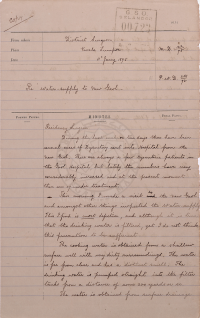
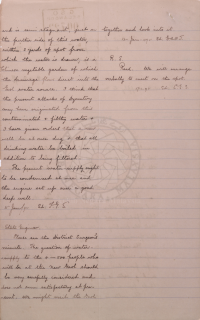
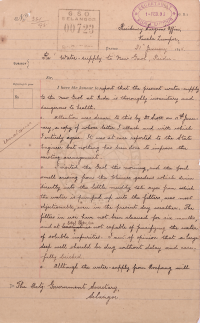

1895-01-11: Laporan awal District Surgeon kepada Residency Surgeon, berkenaan pencemaran sumber air Penjara Pudu yang menjadi punca wabak: “District Surgeon, Kuala Lumpur, 11 January 1895. Re: Water-supply to New Gaol. Residency Surgeon, During the last week or ten days there have been several cases of Dysentery sent into Hospital from the new Gaol. There are always a few dysenteric patients in the Gaol Hospital, but lately the numbers have very considerably increased and at the present moment there are 17 under treatment. This morning I made a visit to the new Gaol and amongst other things inspected the water-supply. This I find is most defective, and although it is true that the drinking water is filtered, yet I do not think this precaution to be sufficient. The cooking water is obtained from a shallow surface well with very dirty surroundings. The water is far from clear and has a distinct smell. The drinking water is pumped straight into the filter tanks from a distance of some 300 yards or so. The water is obtained from surface drainage and is semi stagnant. Just on the further side of this water, within 3 yards of spot from which the water is drawn, is a Chinese vegetable garden of which the drainage flows direct into the Gaol water source. I think that the present attacks of Dysentery may have originated from this contaminated & filthy water & I have given orders that a new well be at one dug & that all drinking water be boiled in addition to being filtered. The present water-supply ought to be condemned at once and the engine set up over a good deep well.” (31/01/1895: |"WATER SUPPLY TO NEW GAOL PUDU. REPORTS IT'S CLEANING THOROUGHLY INVANITARY").
1895-05-14: “NOTIFICATION FROM RESIDENCY SURGEON REGARDING THE ISSUE OF PRISONER DIED CAUSED OF EPIDEMIC DISEASE INDISTRICT OF KUALA LUMPUR WHICH COVERED CONDITION OF PATIENTS, FACILITY, ACCOMMODATION AND FOOD PROVIDED AND PRECAUTION STEPS TO OVERCOME THE DISEASE.” (14/05/1895: |"OUTBREAK CHOLERAIC DIARRHOEA AT PUDU GAOL).
1895-07-15: Resident Surgeon mengesyorkan penaiktarafan dapur bagi memastikan kapasiti memasak untuk semua banduan sekaligus: “I have today examined the kitchens cooking apparatus etc at the gaol - I find that a large quantity of the Kanjee eaten by the prisoners in the morning has to be cooked overnight & mixed with the freshly cooked Kanjee in the morning. This is not advisable… - Resident Surgeon” (16/07/1895: |"KITCHEN ACCOMODATION - PUDU GAOL - FORWARDS MEMO FROM RESIDENCY SURGEON REGARDING - (LAUNDRY): INFORMATION BY THE CAPTAIN-SUPERINTENDENT OF PRISONS REGARDING ON THE REQUEST FOR ADDITIONAL VOTE FOR INSUFFICIENT COOKING ACCOMMODATION IN PRISON WORTH MORE THAN $500.").
1895-08-12: (12/08/1895: |"OUTBREAK OF CHOLERAIC DIARRHOEA IN PUDU GAOL").
1895-08-14: “INFORMATION FROM RESIDENCY SURGEON TO COLONIAL SECRETARY REGARDING THE HEALTH MATTER WHICH CASE OF DISEASE AFFECTED AT THE NEW PRISON AND ORDERED FORTY VAGRANTS TO BE REMOVED FROM THE PRISON TO THE PAUPER HOSPITAL.” (14/08/1895: "REPORT FROM RESIDENCY SURGEON ON OUTBREAK OF CHOLERAIC DIARRHOCA AT PUDOH GAOL - FORWARDS :-").
1895-08-15: (15/08/1895: "REPORTS 13 MORE DEATHS FROM CHOLERAIC DIARRHOEA IN THE PUDU").
1895-08-16: (16/08/1895: |"REPORTS 6 FRESH CASES OF CHOLERAIC DIARRHOEA AND 7 DEATHS AT PUDU GOAL").
1895-08-17: Catatan , Residency Surgeon: “I have the honour to inform you that there have been seven deaths in the Pudu Gaol from Choleraic Diarrhoea during the twenty four hours between 8 a.m. on the 16th and 8 a.m. on the 17th inst. Six fresh cases of this disease have been admitted. 2. From the general appearance of cases and new admissions I am glad to report that an improvement may now be expected. 3. A Tamil woman isolated in every way from the rest of the prisoners have been attacked, and her case will probably prove fatal, the only probable source of contagion in this case seems to be the water-supply which is common to all the prisoners. 4. I have today asked permission to quarantine all prisoners due for discharge from the gaol for five days, this will be done at the old Gaol except in the case of a female due for discharge today, who would be isolated in her own cell and carefully disinfected before being discharged. I consider this only a reasonable precaution, and trust that the requisite permission will be given. 5. Of the vagrants due for discharge, sent by me to the quarantined at he Pauper Hospital three days ago, one has been returned to the Gaol with acute symptoms and has since died, this shows the inadvisability of allowing prisoners to go among the public immediately after their discharge from Gaol. … - E.A.O. Travers, Residency Surgeon.” (17/08/1895: |"REPORTS OF DEATHS FROM CHOLERAIC DIARRHOEA ADMISSION OF 6 FRESH CASES AT PUDU GOAL").
1895-08-19: Statistik kematian banduan bagi separuh pertama bulan Ogos (19/08/1895: |"CHOLERAIC DIARRHOEA IN PUDOH GAOL").
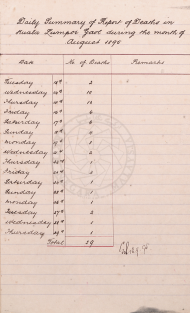
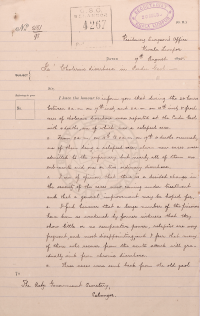
1895-08-20: “NOTIFICATION FROM THE RESIDENCY SURGEON TO THE ACTING GOVERNMENT SECRETARY REGARDING ON THE DEATH REPORTED OCCURRED FROM THE DISEASES THAT HAVE BEEN ATTACKED THE PRISONER AND THE FRESH PURE WATER HAS BEEN SUPPLIED IS A MOST SALUTARY AND ENCOURAGING EFFECT TO THEM.” (20/08/1895: |"CHOLERAIC DIASSHOEA IN PUDU GAOL - FURTHER CASE AT PAUPERS HOSPITAL").
22/08/1895: “NOTIFICATION FROM THE RESIDENCY SURGEON TO THE ACTING GOVERNMENT SECRETARY REGARDING THE DISEASE OCCURRED IN GAOL HOSPITAL WHICH ONLY TWO DEATHS REPORTED AND THIS AILMENT RECORDED FROM DIFFERENT PLACES AND THERE IS NO CONNECTION BETWEEN THESE CASES AND ALL THE POLICE STATION ARE PROVIDED WITH MEDICINE AS A PRECAUTION.” (22/08/1895: "CHOLERAIC DIARRHOEA IN PUDOH GAOL AND VARIOUS PARTS OF KUALA LUMPUR DISTRICT - REPORTS.").
1895-09-21: Pembinaan telaga gantian bagi sumber air warga penjara dan kampung di sekitarnya: “RECOMMENDATION OF RESIDENCY SURGEON CONCERNING THE OUTBREAK OF CHOLERA AT PUDU GAOL AND SURROUNDING VILLAGE AND PRECAUTION WAY TO USE THE LARGE WELL CARED AS THE WATER SUPPLY FOR THEM.” (21/09/1895: |"WELLS AT PUDU GAOL:- RECOMMENDS THAT OLD WELLS SHOULD BE FILLED IN AND A FRESH ONE DUG -").
1895-09-21: Dr. Ernest Aston Otho (E.A.O.) Travers, ketika itu Residency Surgeon, telah merakamkan penghargaan kepada beberapa orang banduan penjara yang sukarela membantu merawat pesakit taun. Salah seorang daripada mereka turut dijangkiti, sehingga meninggal dunia. Dr. Travers mengesyorkan pengurangan tempoh hukuman mereka, lalu dipersetujui oleh pihak Residen: “The actual nursing and feeding of the patients was done by long sentenced prisoners who volunteered for the work, and who were shut up night and day with the cholera cases. One of them contracted the disease and died. I have made a separate list of these convicts, and taking into consideration the good work voluntarily done by them, at a time when other assistance would have been very difficult to obtain. I have much pleasure in laying their names before the Acting Resident in the hope that he may find it possible to grant them some reward in the shape of remission of sentence. … - E.A.O. Travers, Residency Surgeon.” (21/09/1895: |"CHOLERA AT PUDU GAOL:- RECOGNITION OF SERVICES OF CERTAIN CONVICTS: INFORMATION REPORTED BY THE RESIDENCY SURGEON CONCERNING THE DISEASE MATTER IN PUDU GAOL AND DETAIL NAMES OF PRISONER WHO VOLUNTEERED FOR DUTY AS ATTENDANTS ON THAT CASE.").
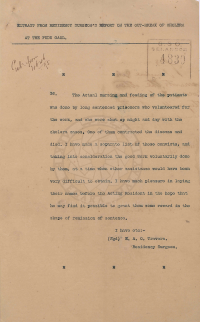
1895-10-15: (15/10/1895: "BONUS TO DRESSER ROZARIO (SALARY $600) & APPRENTICE DRESSERS SEQUERAH & MARBECK ($240 EACH) FOR EXTRA WORK DONE DURING OUTBREAK OF CHOLERAIC DIARRHOEA IN PUDOH GAOL").
1895-10-17: Sebahagian proses siasatan: “COLONIAL SECRETARY INQUIRES THE ACTING BRITISH RESIDENT REGARDING THE RECENT OUTBREAK OF CHOLERA IN THE NEW JAIL OF KUALA LUMPUR FOR DOCUMENTS SHOWING WHO WAS RESPONSIBLE IN SELECTING THE PRISON'S SITE AND THE CONSIDERATION GIVEN TO THE QUESTION OF ITS WATER SUPPLY AND SANITARY SURROUNDINGS.” (17/10/1895: |"PUDU GAOL - ASKS FOR PAPERS SHEWING WHO SELECTED THE SITE & WHO APPROVED OF THE PLANS -").
1895-11-14: “INFORMATION REGARDING THE OUTBREAK OF CHOLERA, BURIAL ISSUE, NEW AREA OF JAIL, CONDITION OF THE CONSTRUCTION AND FINANCIAL DETAILS OF THE PROJECT.” (14/11/1895: "PUDU GAOL SITE - FORWARDS MEMORANDUM FROM MR. H.F. BELLAMY ON THE SUBJECT OF:-").
1895-12-03: Laporan penuh wabak taun di Penjara Pudu, disediakan oleh Dr. Ernest Aston Otho (E.A.O.) Travers, Residency Surgeon: “INFORMATION PREPARED BY THE RESIDENCY SURGEON CONCERNING THE DETAILS OF AN EPIDEMIC OF FATAL DISEASE CAUSED BY WATER QUALITY CONTAIN SEWAGE FROM VEGETABLE GARDENS AND DRINKING WATER.” (03/12/1895: |"REPORT ON OUTBREAK OF CHOLERA AT THE PUDOH GAOL - PUBLICATION OF;").
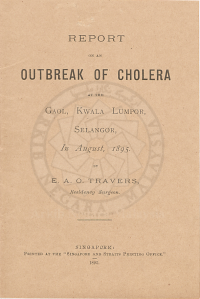

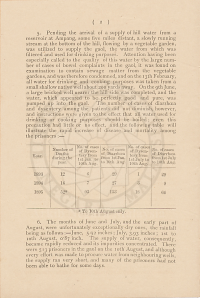
1896-01-20: “A SUBMISSION FROM THE RESIDENT SURGEON TO THE GOVERNOR OF DETAILS ON THE RECENT SPREAD OF CHOLERA IN A PRISON AS TO REQUEST THE GOVERNOR'S SANCTION IN PUBLISHING THE DETAILS AS THE ACTING BRITISH RESIDENT HAS REFUSED TO SANCTION THE PUBLICATION OF THE DETAILS.” (20/01/1896: "CHOLERA AT PUDOH GAOL - REPORT ON OUTBREAK OF - FORWARDS LETTER & CORRESPONDENCE AS TO FOR SUBMISSION TO HIS EXCELLENCY THE GOVERNOR -").
1896-03-19: “REMARKS BY THE STATE SURGEON TO THE GOVERNOR AND COMMANDER IN CHIEF STRAITS SETTLEMENT REGARDING UNSATISFACTORY ON THE DETAILS OF OUTBREAK AT PUDU PRISON THAT FOR INTEREST OF MEDICAL SCIENCE WOULD BE USELESS TO THE GOVERNMENT AND THE DETAILS NOT UNDERSTOOD BY ANYONE OF MEDICAL PROFESSION.” (19/03/1896: "PUBLICATION OF REPORT ON CHOLERA AT PUDOH GAOL. LETTER ADDRESSED BY DR. TRAVERS, MC CLOSKY & HEARTZ FURTHER TO HIS EXCELLENCY THE GOVERNMENT").
1895-1905: Wabak Beri-Beri
Wabak Beri-Beri mula menular dengan berleluasa pada suku akhir kurun ke-19, dan kebanyakan penghidapnya adalah imigran Cina. Sepanjang waktu itu, puncanya tidak dapat dikenalpasti: “Beri-beri began spreading like wildfire throughout Malaya during the last quarter of the 19th century. It was particularly prevalent among young Chinese immigrants and, at that time, nobody had any clue of its origin.” (Alan Teh Leam Seng @ New Straits Times, June 16 2021: |"Malaya led the way in medical research").
LATAR PERISTIWA: Beri-Beri di Tanah Melayu (1848-1910)
Penjara Pudu turut terkesan dengan penularan wabak beri-beri ini, seawal tahun 1895, tidak lama selepas pembukaannya.
1895-10-17: “INFORMATION FROM BRITISH RESIDENT IN KUALA LUMPUR REGARDING THE DISEASE OUT BRAKE IN THE PRISON FACILITY.” (24/10/1895: |"PUDOH GAOL - BERI-BERI:- CAPTAIN SUPERINTENDENT POLICE, STATE ENGINEER AND RESIDENCY SURGEON TO MEET RESIDENT AT PUDU GAOL ON SATURDAY").
1895-11-12: Laporan akhbar berkenaan wabak taun dan beri-beri: “During the last few months, the prison authorities - particularly the Medical branch have had an anxious and busy time. Cholera first appeared at the new Gaol soon after the first large batch of prisoners had been transferred to that building. Within a few weeks no less than 128 cases were reported, of which 68 terminated fatally. Shortly after this, the Gaol was connected with the new service Reservoir, and immediately the progress of the disease was checked. Then, without granting any respite to the Medical Officers who had worked manfully against the cholera, an epidemic of beri-beri, of the most virulent type, made its appearance. This has lasted for several months. During September, out of 37 cases there were 13 deaths, while, last month, out of about 60 cases there were only 8 deaths. The prisoners have all been moved back to their old quarters in Kuala Lumpur, and the fall in the death-rate is attributed to this cause. It appears that the Pudoh Gaol is being erected on the site of an old graveyard, and that the excavation work in progress there let loose the contents of a veritable “Pandora's box” amongst the unfortunate inmates. THe choice of the site is very unfortunate; but, there is reason to hope that, when the construction is finished and the premises have been left to “air” a little, the Pudoh climate will be no worse than any other. It is curious to note that the cholera killed very few of the long sentence prisoners.” (Straits Budget, 12 November 1895, Page 5: |"SELANGOR NEWS").
1895-11-23: “REQUISITION FROM THE CAPTAIN-SUPERINTENDENT OF PRISON TO THE STATE ENGINEER REGARDING THE CLEARANCE OF THE EARTH WHICH SATURATED WITH DECOMPOSED HUMAN REMAINS INCLUDING SKELETONS FROM OLD GRAVES WHERE IT WAS DEPOSITED TEMPORARILY WHICH CAN CAUSE BERI-BERI OUTBREAK.” (23/11/1895: "IMPROVEMENT WORK ON PUDOH HILL AND REMOVAL OF SPOIL AWAY FROM THE GAOL WALL").
1895-11-26: “It appears that several hundred prisoners are still quartered at the Pudoh gaol, and that the beri-beri is by no means stamped out. The cholera epidemic was clearly due to the water supply, for only one case occured after the gaol was connected with the Ampang Waterworks, but the beri-beri cannot be disposed of so easily. The gaol is damp, it is built in a graveyard, and the weather has been admirably suited to the requirements of the germ. During 1894, only 16 deaths occured, while in the third quarter of this year, that is to say, from the 1st of July to September 30th, death has released no less than 105 - chiefly short sentence prisoners.” (Straits Budget, 26 November 1895, Page 5: |"SELANGOR NEWS").
1895-11-30: “A SUBMISSION FROM THE BRITISH RESIDENT TO THE COLONIAL SECRETARY ON DETAILS REGARDING THE OUTBREAK OF A DISEASE AT NEW JAIL IN KUALA LUMPUR, THE NECESSARY TREATMENTS CARRIED OUT, CONDITION OF THE BUILDING, WARDENS AND INSPECTION OF THE FACILITY.” (30/11/1895: "REPORT ON BERI-BERI AT PUDOH GAOL. FORWARDS:-").
1895-12-10: “INFORMATION FROM THE RESIDENCY SURGEON REGARDING THE DAMAGED DRAINAGE SYSTEM CAUSED BY HEAVY RAIN AND THE CLEAN WATER WERE MIXED WITH THE SOIL RESULTING TO DISEASE TO THOSE WHO CONSUME IT.” (10/12/1895: "BERI-BERI AT PUDOH GAOL - (EXTRACT FROM REPORT)").
1896-06-09: Menurut laporan bagi tahun 1895, wabak Beri-Beri dikatakan berpunca dari kawasan lombong di sekitarnya: “The Selangor Medical Report for 1895 confirms the impression that the prevalence or otherwise of beri-beri is largely influenced by mining, more especially in the case of newly opened districts. At Pudoh jail, an outbreak of the disease was traced to the inhalation of specific poison generated in the soil.” (Straits Budget, 9 June 1896, Page 2: |"THE GOVERNOR AND BERI-BERI").
1896-07-10: “An outbreak of beri-beri ni the gaol at Kuala Lumpor, with 31 deaths out of 152 cases, is attributed to soil emanations. An outbreak of cholera later on in the same gaol with 68 deaths out of 126 cases is put down to water supply defects.” (The Singapore Free Press and Mercantile Advertiser, 10 July 1896, Page 2: |"SELANGOR IN 1895").
1896-08-14: (14/08/1896: "BERI-BERI IN THE PUDOH GAOL AND THE WATER SUPPLY - REPORT ON;").
1896-09-23: “RECOMMENDATION OF RESIDENCY SURGEON TO GOVERNMENT SECRETARY REGARDING OF ALL PRISONS WHO ARE SUFFERING FROM THE DISEASE SHOULD BE TRANSMITTED INTO ANOTHER BUILDING WHICH IS QUITE SECURE AND TWO EXTRA WARDENS SHOULD BE SENT TO TAKE THE DUTY.” (23/09/1896: "BERI-BERI IN THE PUDOH GAOL. RECOMMENDS THAT PRISONERS BE TRANSFERED TO THE VAGRANT WARD PAUPER HOSPITAL").
1897-01-19: “A RECOMMENDATION FROM THE STATE SURGEON TO THE GOVERNMENT SECRETARY FOR CONVICTS INFECTED WITH A DISEASE BE INSPECTED BY THE MEDICAL OFFICER AND BE SENT TO WORK OUTSIDE THE JAIL IF THEY PASS THE INSPECTION AND THOSE WHO DID NOT PASS BE WORKING INSIDE THE JAIL.” (19/01/1897: "BERI-BERI CASES AMONG LONG SENTENCED PRISONERS IN PUDOH GAOL").
1897-11-23: (23/11/1897: "BAD HEALTH OF PRISIONERS IN PUDOH GAOL COMMISSION OF ENQUIRY TO REPORT").
1897-12-15: Laporan Suruhanjaya Siasatan terhadap wabak penyakit Beri-Beri ini: “NOTIFICATION FROM THE STATE SURGEON TO THE SECRETARY TO GOVERNMENT PERTAINING THE INFORMATION ON INSPECTION OF THE CIRCUMSTANCES OF BERI-BERI DISEASE AT THE JAIL AND ACQUIRING THE APPROVAL RELATED TO THE DETAILS OF SCHEME MADE OUT BY THE GAOLER WHICH THE SUGGESTION THAT THE DETAINEES SHOULD WORK AT THE HOSPITAL.” (15/12/1897: |"BAD HEALTH PRISONERS IN PUDU GAOL. COMMISSION OF ENQUIRY REPORT - FORWARDS -").
1898-03-08: (08/03/1898: "REPORT UPON THE PUDOH GAOL MADE BY A COMMISSION OF MEDICAL OFFICERS").
1898-03-17: Sangkaan Awal Punca Beri-Beri: Tapak asal Penjara Pudu ialah tanah perkuburan Cina yang besar:
“FORWARDED A DETAIL BY THE ACTING RESIDENT GENERAL AS PREPARED BY COMMITTEE OF MEDICAL OFFICERS IN RESPECT OF BERI-BERI DISEASE AT THE PUDOH JAIL IN WHICH THERE ARE A FEW DEATHS HAVE BEEN REPORTED BY THE OFFICER AND A REQUEST FOR SANCTION TO APPOINT TEMPORARY NATIVE WARDERS DUE TO THE SPREADING OF THE DISEASE AMONG PRISONERS.: I have the honour to submit … a letter from the Acting British Resident, Selangor, enclosing copy of a report on the Pudoh Gaol made by a Committee of Medical Officers in view of the serious outbreak of beri-beri in the gaol, which must be attributed, in the first instance, to the unfortunate selection of a large Chinese burial ground as a site for the institution, and I have the honour to request Your Excellency's sanction for the engagement temporarily of extra Native Warders referred to in para.6 of the Resident's letter. 2. Your Excellency will be gratified to learn from para.5 of the letter that, owing to the action taken on the report, beri-beri has now practically disappeared from the prison. - W.H. (William Hood) Treacher, Ag. Resident-General, F.M.S.” (17/03/1898: |"REPORT BY A COMMITTEE OF MEDICAL OFFICERS ON THE BERI-BERI AT PUDOH GAOL, KUALA LUMPUR. FORWARDS.").
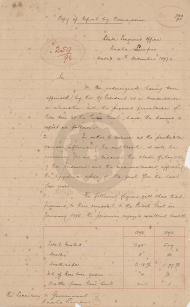
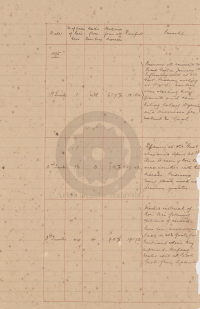
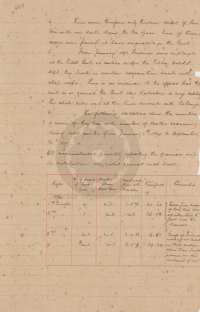
1898-03-19: (19/03/1898: "DISINFECTING AND WHITE WASHING PUDOH GAOL").
Pasca Penubuhan Institute for Medical Research (I.M.R.)
1900-03-18: (18/03/1900: "ASKS FOR A REPORT AS TO THE HEALTH OF PRISONERS IN THE PUDOH GAOL").
1900-03-29: “INFORMATION PERTAINING TO THE ACTIONS TAKEN FOLLOWING THE OUTBREAK OF THE MENTIONED DISEASE SUCH AS ISOLATING THE INFECTED PEOPLE, PLACING A POLICE GUARD OVER AN INFECTED SHED, ALLOWING NO MOVEMENT OF ANIMALS INTO OR IN THE INFECTED AREA, BURNING THE LITTER AND WASHING THE FLOOR.” (29/03/1900: "REPORTS OUTBREAK OF FOOT AND MOUTH DISEASE AT PUDOH").
1900-08-12: Kontroversi tercetus apabila District Surgeon Dr. Percy Netterville (P.N.) Gerrard menyuntik bakteria Beri Beri ke dalam badan seorang banduan di Penjara Pudu, untuk tujuan kajian: “The experiment cannot be permitted. 2. I am surprised that the D.S. should have taken advantage if his position as Surgeon to the Gaol to approach the prisoner with such a suggestion before seeking the authority of the Government for such action. What he did was entirely outside the scope of his duties as Surgeon to the prison, and though I fully recognise and appreciate Dr. Gerrard's anxiety to improve our knowledge of beri beri and to promote the the cause of medical science, I find myself unable to support him when his enthusiasm leads him into unauthorised action. 3. It is very much to be regretted that the prisoner should have been led by his ill timed proposals to entertain hopes which cannot be realised, was especially as he must have presumed that Dr. Gerard was authorised to offer him the alternative. He must be undeceived by the ? of Prisons as soon as possible. 4. I must request that Dr. Gerrard will in future restrict his proposals to prisoners and patients to such matters as fall within the sphere of his duty and authority as District Surgeon, and will refrain from acting as his own initiative in any way which may be in excess of the powers entrusted to him. 5. In view of what Dr. Gerrard has said in para 5 of his minutes, I must point out that it is no part of his duty as District Surgeon to hold interesting conversations with prisoners upon matters apart from their own personal requirements, and that it is very desirable that he should avoid doing so in future. - HCB (Henry Conway Belfield, Pemangku Residen Selangor 1900-1901), 15.8.00.” (12/08/1900: |"APPLICATION FROM DISTRICT SURGEON IN-CHARGE OF GAOL TO INJECT BACTERIUM INTO THE BLOOD OF PRISONER, CHONG SIN NOW AWAITING EXECUTION IN THE PUDU GAOL. FORWARDS").
1900-09-24: (24/09/1900: "BERI-BERI CASES IN THE PUDU GAOL. ASKS TO EXPLAIN WHY THE MATTER HAS NOT BEEN OFFICIALLY REPORTED TO GOVERNMENT").
1900-11-20: “REPORT BY THE DIRECTOR OF PATHOLOGICAL INSTITUTE, FEDERATED MALAY STATES ON THE OBSERVATIONS OF PRISONERS THAT HAD BEEN AFFECTED 5 MILD CASES OF DISEASE AMONGST 35 PRISONERS, 22 CASES OCCURRED IN THE OTHER WORK SHED, 23 IN THE NEW ROAD PARTY, 8 CASES IN THE GRASS CUTTING GANG AND 22 CASES AMONGST CLEANER.” (20/11/1900: |"BERI-BERI AMONG PRISONERS IN THE PUDU GAOL : RESULT OF INVESTIGATION INTO :-").
1901-03-01: District Surgeon, Dr. Percy Netterville (P.N.) Gerrard membantah keputusan pihak atasan untuk mengubah jenis beras dalam makanan banduan, dari beras Siam kepada beras Burma. Beliau menegaskan jenis beras tiada kena mengena dengan wabak Beri Beri: “I have the honour to state that in my opinion the change of diet in Pudoh Gaol namely the substitution of Siamese rice for Rangoon rice is a useless and retrograde experiment. 2. It has been abundantly proved (a) by the Dublin cases (which were diagnosed by the leading Dublin Doctors and by Doctors Manson and Cantlie) (b) by cases which have occured in America, © and by Ship Beri Beri in meat eating crews “that rice has absolutely no place as a causative agent in Beri Beri”. 3. I desire therefore to protest against the continuance of this experiment at Pudoh Gaol, as Beri Beri is the sole disease which has to any extent affected the prisoners during the past year. … I have personally done a considerable amount of work (as you are aware) concerning the Bacteriology of Beri Beri, both at Kwala Kubu and since with Dr. Wright, and have arrived at certain conclusions which may or may not be right; in my opinion however I consider them sufficient ground to go upon in making the statement that rice has nothing to do with the disease beyond the fact that Carbohydrate eating nationalities are more liable to its attacks than those who eat Nitrogeniferous foods. I protest herefore against this experiment and have drawn up a revised diet which will be forwarded if considered desirable. … P.N.Gerrard M.D., District Surgeon” (04/03/1901: |"SUBSTITUITION OF SIAM RICE FOR RANGOON AT PUDOH GAOL. DR. GERRARD, DISTRICT SURGEON, PROTESTS AGAINST :-").
1901-05-02: (02/05/1901: "COMPLAIN BY DR. GERRARD, DISTRICT SURGEON ABOUT CERTAIN REPORT IN PUDOH GAOL MADE BY HIM").
1901-10-21: Wabak disenteri (21/10/1901: "REPORTS OUTBREAK OF DYSENTRY IN THE PUDU GAOL").
1902-03-10: (10/03/1902: "RETURNS OF BERI BERI IN PUDOH GAOL FOR WEEK ENDING 7TH MARCH 1902. FORWARDS :-").
1902-03-17: “FORWARDED BY THE STATE SURGEON THE DETAIL OF THE DISEASE CASES REPORTED IN PUDOH GOAL HOSPITAL FROM8TH TO 4TH MARCH 1902.” (17/03/1902: "RETURN OF BERI BERI CASES IN PUDOH GAOL FOR WEEK ENDING 14TH MARCH 1902.").
1902-03-24: “A SUBMISSION FROM THE STATE SURGEON TO THE SECRETARY TO RESIDENT OF DETAILS ON THE NUMBER OF PRISONERS INFECTED WITH BERI-BERI TREATED AT THE PUDU GAOL HOSPITAL AND THE DISTRICT HOSPITAL.” (24/03/1902: "RETURN OF BERI BERI CASES IN PUDOH GAOL FOR WEEK ENDING 21ST MARCH 1902").
1902-03-25: “THE SUGGESTION FROM STATE SURGEON TO THE SECRETARY TO RESIDENT THAT THE SIX SHEEP AND A BIG MONKEY AT THE INSTITUTE OF MEDICAL RESEARCH BE KEPT IN ONE OF THE CELLS AT THE GAIL FOR SIX MONTHS OR SO TO SEE IF IT DEVELOPS DISEASE AND AS A SUBJECT OF EXPERIMENT.” (25/03/1902: "EXPERIMENT OF BERI BERI IN PUDOH GAOL UPON ANIMALS").
1902-04-01: (01/04/1902: "RETURN OF BERI BERI CASES IN PUDOH GAOL FOR WEEK ENDING 28TH MARCH 1902").
1902-04-07: “INFORMATION FORWARDED BY THE STATE SURGEON TO THE SECRETARY TO RESIDENT KUALA LUMPUR PERTAINING TO THE WEEKLY DETAILS OF PRISONERS TREATED FROM A DISEASE AT TWO OF THE STATE'S HOSPITALS AS RECORDED FROM THE 29TH MARCH 1902 TO 4TH APRIL 1902.” (07/04/1902: "RETURN OF BERI BERI CASES IN PUDOH GAOL FOR WEEK ENDING 4TH APRIL 1902").
1902-04-14 (14/04/1902: "BERI-BERI IN PUDOH GAOL").
1902-04-15 (15/04/1902: "RETURN OF BERI BERI CASES IN PUDOH GAOL FOR WEEK ENDING 11TH APRIL 1902").
1902-04-21: (21/04/1902: "RETURN OF BERI-BERI CASES IN PUDOH GAOL FOR WEEK ENDING 1ST APRIL 1902").
1902-04-29: “SUBMISSION BY STATE SURGEON PERTAINING TO DETAILS OF INCREASING OF BERI-BERI DISEASE OCCURS IN PUDU PRISON WHICH CAUSE THE DEATH OF MANY PRISONERS AND ADMITTED IN HOSPITAL AND REPLIED BY GAOL OFFICE TO REQUEST FOR APPOINTMENT OF WARDER TO ASSIST IN ORDER TO MANAGE THE CASE.” (29/04/1902: "INCREASE NUMBER OF BERI-BERI IN PUDOH GAOLL. REPORT:-").
1902-06-14: Laporan statistik wabak Beri-Beri sehingga Mei 1902 oleh State Surgeon Dr. Ernest Aston Otho (E.A.O.) Travers:-
“The number of Beri Beri cases occuring in the Gaol during the last five years and up to end of May 1902 are as follows -”
| Admission | Deaths | |
|---|---|---|
| 1897 | 276 | 54 |
| 1898 | 56 | 2 |
| 1899 | 73 | 7 |
| 1900 | 201 | 7 |
| 1901 | 176 | 5 |
| 1902 (1st Jan - May 31st) | 345 | 7 |
“These are actual admissions to hospital, a large number of slight cases have also occured which have not necessitated admission to hospital. The admissions to hospital, with deaths, give a very fair index of the prevalence of Beri Beri ni the Gaol. - 10.6.02, Sd/- E.A.O.T.” (Sumber: 14/06/1902: |"PUDOH GAOL, STATISTIC OF BERI-BERI CASES AND DEATHS").
1902-06-24: (24/06/1902: "STATEMENT OF BERI BERI CASES, PUDOH GAOL").
1902-07-01: “NOTIFICATION FROM ACTING SECRETARY TO RESIDENT TO TREASURY REGARDING THE AMOUNT OF $3,955 IS REQUIRED FOR PAYMENT IN PUBLIC WORK SPECIAL SERVICES, VENTILATION AND IMPROVING PUDU GAOL.” (01/07/1902: "OBSERVATION ON BERI-BERI PUDOH GAOL").
1902-07-02: “INFORMATION BY THE ACTING STATE SURGEON REGARDING THE TRANSMISSION OF WEEKLY RECORD AMONG PRISONERS WHO SUFFER FROM BERI-BERI DISEASE WHICH SLIGHTLY DECREASED IN NUMBER OF CASES AT PUDOH GAOL DATED ON 27TH JUNE 1902.” (02/07/1902: "BERI-BERI STATEMENT. PUDOH GAOL WEEK ENDING 27TH JUNE").
1902-07-14: “INFORMATION BY THE ACTING STATE SURGEON REGARDING DETAILS OF BERI-BERI CASE AMONG PRISONERS FOR WEEKLY RECORD WHICH IS TREATED AT PUDOH GAOL HOSPITAL FROM 5TH TO 11TH JULY 1902.” (14/07/1902: "BERI BERI CASES, PUDOH GAOL WEEKLY STATEMENTS OF :-").
1902-07-22: “SUBMISSION BY THE STATE SURGEON TO SECRETARY TO RESIDENT REGARDING THE DETAILS OF BERI-BERI CASES IN PUDOH PRISON HOSPITAL DATED ON 18TH JULY 1902.” (22/07/1902: "RETURN OF BERI-BERI CASES PUDOH GAOL. WEEK ENDING 18TH JULY").
1902-07-28: “INFORMATION BY THE ACTING STATE SURGEON REGARDING THE DETAILS RECORD OF BERI-BERI CASES AMONG THE PRISONERS IN PUDOH GAOL FOR A WEEK ENDING ON 25TH JULY 1902 WHICH SHOW CERTAIN DECREASED IN THE NUMBERS OF PATIENTS.” (28/07/1902: "BERI-BERI CASES PUDOH GAOL WEEK ENDING JULY 25TH").
1902-08-06: “INFORMATION BY THE ACTING STATE SURGEON REGARDING THE DETAILS OF BERI-BERI CASES WITHIN PUDOH GAOL AMONG PRISONERS FOR A WEEK ENDING ON 1ST AUGUST 1902 WHICH HAVE SHOWN THE DECREASE IN NUMBER OF PATIENTS AT PUDU HOSPITAL.” (06/08/1902: "BERI-BERI CASES PUDOH GAOL WEEK ENDING 1ST AUGUST").
1902-08-12: “INFORMATION BY THE ACTING STATE SURGEON REGARDING DETAILS OF RETURN FOR BERI-BERI CASES WITHIN PUDOH GAOL AMONG PRISONERS FOR A WEEK ENDING ON 8TH AUGUST 1902 WHICH SHOWS RAPID IMPROVEMENT AND A DECREASE NUMBER OF PATIENTS AT THE DISTRICT HOSPITAL.” (12/08/1902: "BERI-BERI CASES PUDOH GAOL WEEK ENDING 8TH AUGUST").
1902-09-05: (05/09/1902: "BERI BERI IN PUDOH GAOL").
1902-10: Lawatan Dr H.E. Durham
Lawatan Dr Herbert Edward (H.E.) Durham ke Penjara Pudu, kemungkinan sebahagian daripada ekspedisi penyiasatan penyakit Beri-Beri di Semenanjung Tanah Melayu dan Pulau Krismas: “He was subsequently in charge of an expedition to investigate beriberi in the Malay Peninsula and on Christmas Island, organised by London School of Tropical Medicine.” (Wikipedia: Herbert Durham):-
- 20/09/1902: Permohonan lawatan Dr Herbert Edward (H.E.) Durham: (20/09/1902: "TELEGRAM RE' PUTTING BIRDS IN CELLS, PUDU GAOL").
- 27/09/1902: “INQUIRY FROM THE DIRECTOR INSTITUTE OF MEDICAL RESEARCH TO THE RESIDENT GENERAL FOR THE STATE SURGEON'S EXPLANATION WHICH HE OBTAINS THE PERMISSION FOR DR. H.E. DURHAM TO VISIT KUALA LUMPUR PRISON.” (27/09/1902: "INTERFERENCE OF DR. DURHAM IN CONNECTION WITH EXPERIMENTAL OBSERVATIONS IN PUDOH GAOL").
- 01/10/1902: Lawatan Dr Herbert Edward (H.E.) Durham diluluskan: “I have authorised Dr. Durham to visit the Gaol in the interests of science and to carry on any observations there that he may think fit. 2. He will not of course interfere in any way with the discipline of the Gaol. 3. Dr. Durham may also have samples of rations given him ? 2 or more days which he will select. 4. Let Supt. Prisons see this. - A.R.V.(Arthur Reid Venning)? 29.9.02” (PEJABAT SETIAUSAHA KERAJAAN NEGERI SELANGOR, 01/10/1902: |"DR. DURHAM'S VISIT TO PUDU GAOL AUTHORISED: NOTIFICATION FROM BRITISH RESIDENT THAT DR.DURHAM HAS BEEN AUTHORIZED TO VISIT THE GAOL IN THE INTEREST OF SCIENCE AND TO CARRY ON OBSERVATION RELATED TO RATION AND HE WILL NOT INTERFERE IN ANY OF THE GAOL DISCIPLINE.").
Pasca Penglibatan Dr. W.L. Braddon
1902-10-16: “INFORMATION REGARDING THE PROCEDURES AFTER POST MORTEMS ON DECEASED PRISONERS ARE MADE IN WHICH THE RESIDENT GENERAL INQUIRES AS TO WHETHER ANY DOCUMENTS ARE RELEASED AFTER THE OPERATION.” (16/10/1902: "REFUSAL OF INSTITUTE MEDICAL RESEARCH TO SUPPLY REPORT OF POST-MORTEM EXAMINATION, PUDOH GAOL LETTER FROM STATE SERGEON RE'").
1903-01-03: Pengarah Institute for Medical Research (I.M.R.), Dr. Hamilton Wright, mengisytiharkan wabak Beri-Beri telah cukup terkawal, dan peranan mereka selesai: “I have the honour to inform you that so far as the Kuala Lumpur Gaol is concerned I have finished my observations on Beri-beri experimental, clinical, post-mortem, and the powers granted me in yout R.G. 928/00 and by the official Notification in Gazette No 9/00 are no longer needed. 2. In resigning those powers and my position in the gaol it gives me great pleasure to testify to the consideration and courtesy I have for three years experienced at the hands of the entire gaol staff from the Superintendent of Prisons downwards. I would especially mention the painstaking efforts along many lines of the gaoler, Mr. Galloway.” (03/01/1903: |"BERI - BERI OBSERVATIONS, PUDOH GAOL, FINISHED").
1903-04-22: (22/04/1903: "PERMISSION FOR DIRECTOR OF THE INSTITUTE FOR MEDICAL RESEARCH AND HIS ASSETS TO VISIT PUDOH GAOL").
1903-05-19: Wabak beri-beri dilaporkan reda: “The medical department is to be congratulated on Pudoh Gaol being free from beri beri, besides other diseases being but rare occurences. A spacious extra mural hospital, adjoining the gaol walls, is now under construction.” (Straits Echo, 19 May 1903, Page 1: |"Kwala Lumpor Notes").
1904-02-24: (24/02/1904: "PARTIAL RESUMPTION OF INTRA-MURAL WORK, PUDOH GAOL").
1904-03-24: (24/03/1904: "EXTRA MURAL WORK, PUDOH GAOL - VISIT OF DIRECTOR OF INSTITUTE FOR MEDICAL RESEARCH TO THE GAOL").
1904-11-28: Hospital Beri-Beri siap dibina di luar Penjara Pudu (28/11/1904: "COMPLETION OF EXTRA MURAL BERI BERI HOSPITAL, PUDOH GAOL - RE :-").
1904-12-17: Bilangan banduan yang sakit bertambah (17/12/1904: |"INCREASE OF THE NUMBER OF 'SICK' IN PUDOH GAOL - RE :-").
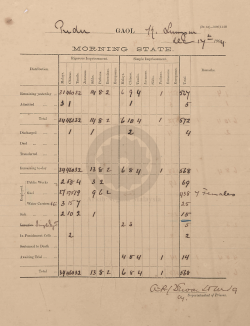
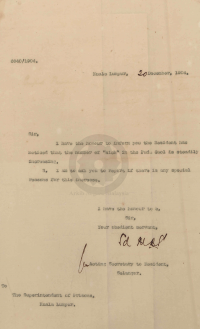
1905-03-20: Keperluan Warden tempatan tambahan bagi membantu kawalan penyakit beri-beri: “In a report forwarded to me by the Inspector of Prisons, Federated Malay States, of a recent visit paid by him to the Pudu Prison, my attention has been invited to the fact that the completion and occupation of the new extra-mural hospital ward for beri-beri patients necessitates the employment of six additional Native Warders for guard duty thereon. … 5. The health of the Prisoners is at the present time most excellent. Out of 540 prisoners there were only 11 in hospital, and there were no beri-beri cases at all. My personal knowledge of this prison and its unfortunate past history enables me to state with some confidence that the health of the inmates has at no previous period been so uniformly good as at the present time. 6. The State Surgeon informs me that in his opinion, and in that of Dr. Daniels and other Medical Officers, it is most desirable that every beri-beri case should, immediately on the appearance of the disease, be segregated in the special ward, by which precaution it is expected that the Prison will be effectually protected from such outbreaks as have periodically occured in the past. I am strongly of opinion that the Government should make every reasonable effort to second the endeavours of the Medical Officers in effectuating precautionary measures, and I am therefore anxious to provide the additional staff which is necessary in order to give the prisoners full advantage of the newly erected ward. … - Sd. Rey(?), British Resident, Selangor.” (20/03/1905: |"INSPECTION OF THE PUDU PRISON - EMPLOYMENT OF ADDITIONAL NATIVE WARDERS - RE :-").
1905-08: State Surgeon Selangor ketika itu, Dr. Ernest Aston Otho (E.A.O.) Travers telah melaporkan kesesakan dalam penjara ketika itu. 522 bilik tahanan tidak dapat menampung 606 orang banduan. Maka selebihnya terpaksa ditempatkan di hospital penjara, lalu berhadapan risiko penularan wabak beri-beri yang sedang berleluasa: “I have the honour to draw your attention to the overcrowded state of the Pudoh Gaol. 2. On the occasion of my visit on August 11th the prison strength was 651. Thirty civil prisoners and persons awaiting trial were in the civil prison, and there were twelve female prisoners, deducting these from the total of 651 there remains 606 convicts to be accomodated in the criminal prison. 3. As there are only 522 cells, some 84 prisoners have to be provided for. This was, I find, managed by dividing them between the hospital and the civil prison. 4. It is hardly necessary for me to point out how objectionable this arrangement is, the fact that some 40 healthy convicts are put into the hospital to sleep every night is the best possible method by which disease can be spread among the prisoners. 5. It has recently been suggested that beri-beri is in nearly every instance introduced into the Gaol by vagrants, and prisoners awaiting trial, if this is the case the fact that a large number of convicted criminal prisoners are brought back into the civil prison every night to sleep is extremely likely to be followed by a fresh outbreak of beri-beri. 6. I regret that at the risk of causing inconvenience I cannot allow healthy prisoners to be put into the hospital to sleep and I will ask the Superintendent of Prisons to give instructions accordingly. 7. I would suggest that in order that this very serious overcrowding may be dealth with before it leads to an outbreak of sickness. (a) The Police be asked to refrain from arresting vagrants except in special cases. (b) If possible, some fifty prisoners, be transferred to some other prison in the F.M.S.” - E.A.O. Travers, State Surgeon's Office, Kuala Lumpur, 16th August, 1905.
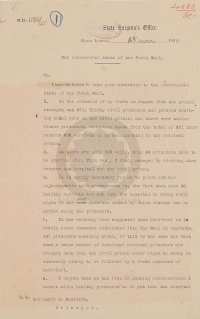
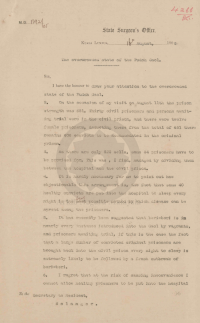
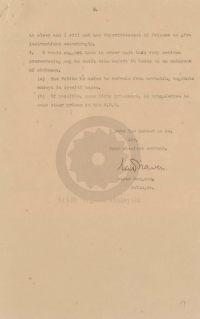
(Sumber: PEJABAT SETIAUSAHA KERAJAAN NEGERI SELANGOR, 04/09/1905: |"OVERCROWDED STATE OF THE PUDU GAOL - REPORT OF ;-").
1905-10-31: (31/10/1905: "HOSPITAL FOR BERI-BERI PATIENTS AT PUDU GAOL - RE :-").
1905 (Akhir): Wabak Beri-Beri Terkawal
1905-10: Di dalam surat terbuka Dr. Travers, sebagai maklumbalas kepada makalah Dr. Hamilton Wright sebelumnya, beliau menjelaskan langkah-langkah pembersihan yang telah dibuat di Penjara Pudu, bagi mencegah penularan wabak Beri-beri di situ (E. A. O. Travers, The Journal of Hygiene Vol. 5, No. 4 (Oct., 1905), pp. 536-539: |"Relating to the Paper Entitled "The Successful Application of Preventive Measures against Beri-Beri," by Dr. Hamilton Wright").
Menurut beberapa laporan yang dikeluarkan pada tahun 1906, keadaan telah beransur pulih mulai suku keempat tahun 1905:-
- “I have the honour to report that the health of the prisoners & sanitary conditions of the Gaol has be(en) satisfactory during the 4th quarter. The average number of prisoners has been 633.75 daily & the average number of sick 17.15. Of the total, 75 admitted to hospital during the quarter, 29 were cases of Beri-Beri, & 14 cases of dysenterry. Beri-Beri, I'm pleased to say has been steadily decreasing, there are now 4 mild cases left in hospital. There has been one death from Beri-Beri & this was the case of a man who had had three attacks & whose heart was very weak. Most of the Beri-Beri cases were long sentenced men occupying 'D' block, & employed in the rattan shed.” (PEJABAT SETIAUSAHA KERAJAAN NEGERI SELANGOR, 18/01/1906: |"PUDU GAOL - REPORT FOR THE 4TH QUARTER 1905").
- “I have the honour to report to you that the amount of sickness in the Gaol during the year has been remarkably little, especially when compared to the amount of prisoners. The average daily amount of prisoners was 603.23; whereas the average daily amount of sick was only 16.86: a total of 300 being treated in hospital during the year; This amount would have been much less if we exclude sick vagrants who were sent to the Gaol. The total amount of deaths was 14, six of these vagrants & heavy opium smokers. The percentage of deaths to total treated was 4.91. The largest number admitted for any one disease was in the case of Beri-Beri: 96 being admitted during the year; Most of these were mild cases; the men attacked were for the most part Middle Grade men quartered in 'B' block & working in the rattan shed. There was one death in a case of chronic Beri-Beri with severe heart complication. There were only four cases left in hospital at the end of the year. The extra-mural hospital was thought to bt insufficiently ventilated at night when the numerous doors had to be closed. It has therefore been decided to replace these doors for iron gratings. There were 20 cases of dysentery. 14 of these occured within a short period of each other; the cause was probably from men drinking the water from the well in the Gaol, which had been infected by a prisoner. This outbreak stopped when the water was disinfected.” (PEJABAT SETIAUSAHA KERAJAAN NEGERI SELANGOR, 09/04/1906: |"HEALTH REPORT ON PUDU GAOL FOR 1905").
- (12/04/1906: "HEALTH REPORT ON PUDOH GAOL FOR 1ST QUARTER 1906").
LATAR PERISTIWA: Beri-Beri di Tanah Melayu (1848-1910)
1908: Wabak Malaria
Wabak malaria telah pun melanda daerah Klang seawal tahun 1901. State Surgeon Selangor ketika itu, Dr Malcom Watson, berjaya mengawal wabak ini dengan mengeringkan kawasan paya di situ. Pada tahun 1907, beliau bersara dan meneruskan kajiannya, dan menjadi penasihat kesihatan di ladang-ladang seluruh Selangor: “It all began at the turn of the 20th century, when the Selangor state surgeon Dr Malcolm Watson started work on malaria control following a serious epidemic that floored many Klang residents. With full government aid and a $30,000 Sanitary Board grant to drain waterlogged swamps, Watson initiated mitigating measures that were met with resounding success both in Klang and Port Swettenham. By 1907, Dr Watson resigned from government service and began devoting more time and study towards malaria. He collected invaluable data and gained new insights into the disease by serving as medical adviser to many rubber estates that were rapidly opening up all over Selangor.” (Alan Teh Leam Seng @ New Straits Times, June 16 2021: |"Malaya led the way in medical research").
LATAR PERISTIWA: Malaria di Tanah Melayu (1880-1910)
1902-05-22: Masalah nyamuk telah dilaporkan di Penjara Pudu beberapa seawal tahun 1902 lagi, namun belum ada penularan wabak malaria yang serius (22/05/1902: "MOSQUITOES IN PUDOH GAOL").
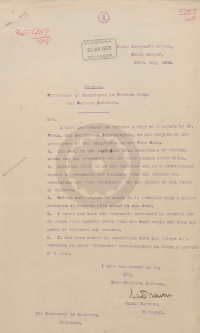
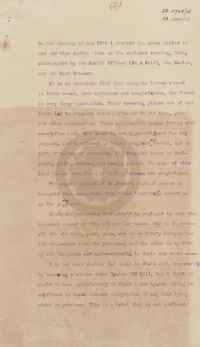
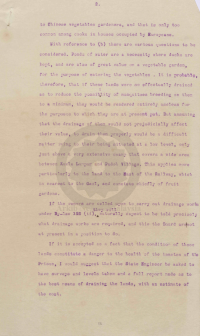
Sekitar Mei 1908, State Surgeon Dr. Ernest Aston Otho (E.A.O.) Travers melaporkan warga Penjara Pudu mengalami serangan nyamuk yang teruk. Kes malaria kian meningkat. Beliau mencadangkan sama ada kebun atau kolam sekitar 500 kaki dari penjara dikambus untuk mengelak takungan air yang menjadi tempat pembiakan nyamuk: “I have the honour to forward a copy of a report by Mr. Pratt, the Government Entomologist, on the subject of the prevalence of the mosquitoes at the Pudu Gaol. 2. The Gaol is now infested with mosquitoes of various kinds and the prisoners are severely bitten every night. 3. Malarial fever is on the increase and as a considerable number of prisoners are admitted with the disease the conditions are very favourable for the spread of all forms of Malaria. 4. Unless some action is taken it is probable that a severe outbreak of Malaria will occur in the Gaol. 5. I would ask that the vegetable gardeners be removed for at least five hundred yards from the Gaol walls and that the pools be levelled and drained. 6. It has been proved by experiment that the flight of a mosquito is under favourable circumstances at least a quarter of a mile. … - E.A.O. Travers, State Surgeon, Selangor.”
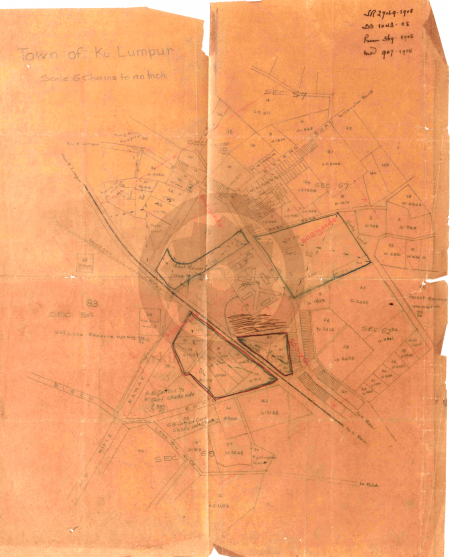
Peta sekitar Penjara Pudu (1908). State Surgeon Dr. Ernest Aston Otho (E.A.O.) Travers, bersama beberapa orang lain telah meninjau kawasan-kawasan yang ditanda di dalam peta. Mereka menemui takungan air dalam bekas, kolam, parit, dan paya di situ, yan menjadi sarang pembiakan nyamuk: “On the morning of the 17th I visited the areas marked in red and blue double lines on the enclosed tracing, being accompanied by the Health Officer (Dr.A.Reid), the Gaoler, and the Gaol Dresser. It is an undoubted fact hat mosquito larvae abound in these areas, both culicines and anophelines, the former in very large quantities. Their breeding places are two kinds (a) In stagnant water collected in old tins, jars and other receptacles. These receptacles become filled with water after rain. The water is not apparently used for any purpose, and is allowed to become stagnant and foetid, and is full or larvae of culicines. (b) Stagnant water in duck-ponds, pools, drains, and swampy ground. In water of this kind larvae were found of both culicines and anophelines. The expert opinion of Dr.Travers must of course be accepted that mosquitoes from these localities travel as far as the Prison.”
Kemungkinan ini menjadi pencetus awal langkah serta undang-undang pencegahan tempat pembiakan nyamuk: “There are two means that should be employed to meet the nuisance caused in this and similar cases. One is to remove all the old tins, pots, jars, and other likely receptacles for rain-water from the premises, and the other is to fill up all the ponds and systematically to drain the whole area. I am not sure whether (a) could be dealt with temporarily by issuing a notice under By-law 192 (ii), but I think it would be more satisfactory to frame a new by-law making it an offence to leave disused receptacles of any kind lying about on premises. This is a habit that is not confined to Chinese vegetables gardeners, and that is only too common among cooks in houses occupied by Europeans.”
(Sumber: PEJABAT SETIAUSAHA KERAJAAN NEGERI SELANGOR, 09/05/1908: |"PREVALENCE OF MOSQUITOES OF THE PUDU GAOL").
Menjelang tahun 1911, Dr Watson berjaya mengenalpasti spesis nyamuk malaria dan kaedah berkesan untuk mengawal pembiakannya. Kaedahnya ini diterbitkan oleh Liverpool School of Tropical Medicine pada tahun 1911, yang menjadi antara panduan utama kawalan wabak ini: “Working at a time when there was near complete ignorance of the different Malayan mosquito species, Watson successfully sought out the culprit that acted as vector for the malarial pathogen and began devising effective methods to interrupt its life cycle through breeding prevention and stopping the larvae from reaching adulthood. Watson strongly encouraged drying up mosquito breeding sites by using underground pipes to eliminate surface water retention, keeping seawater off the land by building bunds, and the destruction of young larvae with oil. His effective techniques and their splendid success record were published in 1911 by the Liverpool School of Tropical Medicine. Apart from blazing a trail for succeeding generations to follow, his book also laid down basic principles of malaria control, which remained unchallenged for many decades.” (Alan Teh Leam Seng @ New Straits Times, June 16 2021: |"Malaya led the way in medical research").
1911-11-24: (PEJABAT SETIAUSAHA KERAJAAN NEGERI SELANGOR, 24/11/1911: |"WELLS AT PUDU GAOL").
| Laman Utama | Hubungi Kami | ||||||||
| Siri Cebisan Sejarah: | Bangi | Gambang | Hutan | Ipoh | Kajang | Kuala Lumpur | Kuantan | Pulau Pinang | Hubungi Kami |
